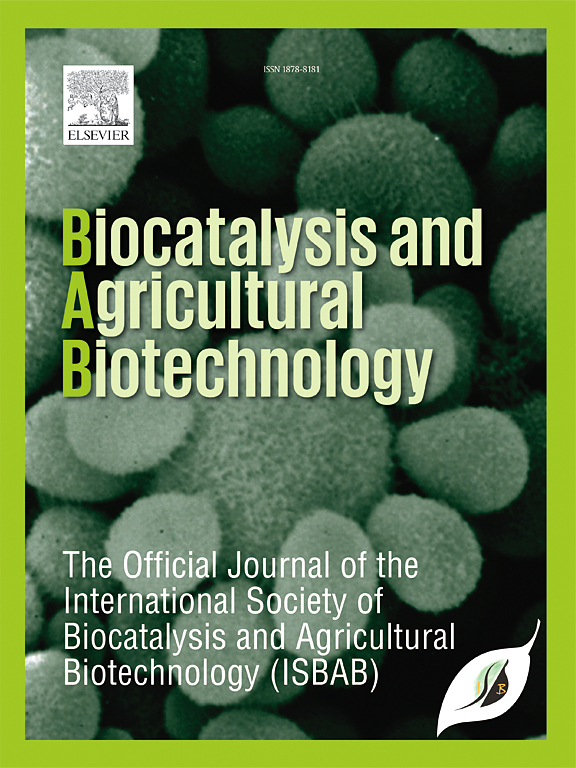Optimization of ultrasonic-assisted extraction (UAE) for phenolics and antioxidant activity from cocoa (Theobroma cacao) leaves and phytochemical profiling using GC-MS and LC-HRMS
IF 3.4
Q2 BIOTECHNOLOGY & APPLIED MICROBIOLOGY
引用次数: 0
Abstract
Cocoa (Theobroma cacao) leaves, often discarded as agricultural by-products, are a valuable source of phenolic compounds with strong antioxidant properties. This study aims to optimize the ultrasound-assisted extraction (UAE) process to maximize the total phenolic content (TPC) and antioxidant activity (AA) of cocoa leaves using response surface methodology (RSM) with a central composite design (CCD). Three variables—ethanol concentration (70–90%), ultrasonic irradiation time (30–60 min), and solvent-to-solid ratio (5–15 mL/g)—were evaluated for their effects on TPC and AA. The RSM quadratic model determined the optimum extraction conditions as 89.34% ethanol, 45.87 min ultrasonic irradiation, and 10.03 mL/g solvent-to-solid ratio, with predicting TPC and AA values of 129.67 mg GAE/g extract and 44.52 %, respectively. Experimental validation yielded TPC of 118.84 ± 0.83 mg GAE/g and antioxidant activity of 42.01 ± 1.14 %, aligning with predictions within a 5% error margin. Furthermore, GC-MS and LC-HRMS analyses identified key phenolics, including (+)-procyanidin B2, (−)-epicatechin, and D-(+)-catechin, alongside other compounds such as squalene. The findings demonstrate that UAE was a highly efficient method for extracting bioactive compounds from cocoa leaves, facilitating the repurposing of agricultural by-products and potentially enhancing the functional value of cocoa leaf-derived products.

超声辅助提取可可叶中酚类物质和抗氧化活性的优化及GC-MS和LC-HRMS的植物化学分析
可可叶,通常作为农业副产品被丢弃,是具有强抗氧化特性的酚类化合物的宝贵来源。本研究旨在利用响应面法(RSM)和中心复合设计(CCD)优化可可叶超声辅助提取(UAE)工艺,以最大限度地提高可可叶总酚含量(TPC)和抗氧化活性(AA)。考察乙醇浓度(70-90%)、超声照射时间(30-60 min)和液固比(5-15 mL/g)对TPC和AA的影响。RSM二次模型确定最佳提取条件为乙醇浓度89.34%,超声照射时间45.87 min,料液比10.03 mL/g,预测TPC值为129.67 mg /g, AA值为44.52%。实验验证得到TPC为118.84±0.83 mg GAE/g,抗氧化活性为42.01±1.14%,与预测误差在5%以内。此外,GC-MS和LC-HRMS分析鉴定了关键的酚类物质,包括(+)-原花青素B2,(−)-表儿茶素和D-(+)-儿茶素,以及其他化合物,如角鲨烯。研究结果表明,阿联酋是从可可叶中提取生物活性化合物的一种高效方法,促进了农业副产品的再利用,并有可能提高可可叶衍生产品的功能价值。
本文章由计算机程序翻译,如有差异,请以英文原文为准。
求助全文
约1分钟内获得全文
求助全文
来源期刊

Biocatalysis and agricultural biotechnology
Agricultural and Biological Sciences-Agronomy and Crop Science
CiteScore
7.70
自引率
2.50%
发文量
308
审稿时长
48 days
期刊介绍:
Biocatalysis and Agricultural Biotechnology is the official journal of the International Society of Biocatalysis and Agricultural Biotechnology (ISBAB). The journal publishes high quality articles especially in the science and technology of biocatalysis, bioprocesses, agricultural biotechnology, biomedical biotechnology, and, if appropriate, from other related areas of biotechnology. The journal will publish peer-reviewed basic and applied research papers, authoritative reviews, and feature articles. The scope of the journal encompasses the research, industrial, and commercial aspects of biotechnology, including the areas of: biocatalysis; bioprocesses; food and agriculture; genetic engineering; molecular biology; healthcare and pharmaceuticals; biofuels; genomics; nanotechnology; environment and biodiversity; and bioremediation.
 求助内容:
求助内容: 应助结果提醒方式:
应助结果提醒方式:


